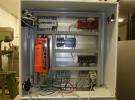Dear Labjack,
I am interested in purchasing the Labjack T7 pro model. We are currently looking to interface 32 strain gauges of about 120Ohm(we may even use 3000Ohm) for data acquisition at 1000Samples/Sec. The question is, what is the delay between each channel? Can it be possible to acquire simultaneous sampling of 32 strain sensors all at 1000Samples/Sec. Our end goal is to have this data sent to our cloud server, but initially we would use to log into our local computer. We also plan to set a type of trigger mechanism in such a way that, only if the sensors have been excited, should the acquisition be saved to the cloud or computer. Could you kindly advice if such a solution is possible with the LABJACK T7 pro, and if so, could you kindly advice what Labjack architecture i could purchase. I am currently looking at the Labjack T7 Pro, wifi, with the 84 analog input expander. And the LJtick amplifier for the analog input. I will fabricate the wheatstone bridge input to the 32 LJtick amps myself. And probably, use the wifi to connect to our gatewat to transmit the data to the cloud once triggering takes place.We plan to measure strain signals typically from 1microstrain to 500 microstrain. Kindly help.



.png%3Fitok=PHGBxf6M)


.jpg%3Fitok=B1YcuDFK)
.png%3Fitok=Ybt-OlgU)
to interface 32 strain gauges of about 120Ohm
Note that the 2.5V excitation on the LJTIA is capable of 25 mA. 2.5/120 is 21 mA, so the Vref on the LJTIA can only excite 1 bridge made up of 120 ohm elements. For 2 bridges further consideration would be needed for excitation.
The question is, what is the delay between each channel? Can it be possible to acquire simultaneous sampling of 32 strain sensors all at 1000Samples/Sec.
32 channels at 1000 scans/second is 32k samples/second. That is too fast to use higher gains on the T7 so you are correct in your plans to use external per-channel amplifiers (LJTIAs):
https://labjack.com/support/datasheets/t7/appendix-a-1
With external amplifiers, you have higher voltage signals and then use the +/-10V analog input range. From Table A.1.5 you can see that the interchannel delay will be 15us at 32k samples/second, and you can add dummy channels to your list to push the sample rate over 60k which will drop interchannel delay to 8us.
Our end goal is to have this data sent to our cloud server, but initially we would use to log into our local computer.
Note that 32k samples/second is too fast for the built-in WiFi as described before Table A.1.4:
https://labjack.com/support/datasheets/t7/appendix-a-1
If you need wireless, you would need to use the Ethernet connection on the T7 and then use standard networking equipment to convert to WiFi:
https://labjack.com/support/app-notes/convert-ethernet-to-wifi
We also plan to set a type of trigger mechanism in such a way that, only if the sensors have been excited, should the acquisition be saved to the cloud or computer.
It might be possible to write a Lua script that detects your trigger and turns stream on and off as you describe, but it sounds pretty complex. I would highly suggest you just stream all the data to your software and let your software decide what to keep and discard.
In that case we would use 350Ohm and higher strain gain resistances to avoid this issue.
It is a bit strange to me that inserting dummy channels would reduce this interchannel delay to 8uS. But as per your advice i would use this feature and it would benefit greatly.
So the idea is to have ethernet connected between say a raspberry PI/windows computer and the LABJACK. The raspberry PI/windows computer would be responsible to keep or discard data based on the trigger when the LABJACK is set to stream mode. The raspberry PI/windows computer would also be responsible to send data to the cloud. Is such a setup possible? if so could you suggest coding examples on how i would be able to do it.
Yes, can this be done using say computer scripting to keep and send data to the cloud. If so would you please able to advise how to achieve this ?
In that case we would use 350Ohm and higher strain gain resistances to avoid this issue.
That works. If you need to use lower resistance bridges you can add LJTick-Vref-25s as needed.
So the idea is to have ethernet connected between say a raspberry PI/windows computer and the LABJACK. The raspberry PI/windows computer would be responsible to keep or discard data based on the trigger when the LABJACK is set to stream mode. The raspberry PI/windows computer would also be responsible to send data to the cloud. Is such a setup possible? if so could you suggest coding examples on how i would be able to do it.
We have examples that demonstrate reading stream data.
As for deciding what data to keep or discard, that is a matter of processing arrays of values, and not anything specific to the LabJack, so we don't have an example that demostrates that.
As for sending data to the cloud, how you do that depends on your cloud service.
Dear Labjack,
Thank you for your advice. We are currently pursuing a project involving the LABJACK to input 64 channels from strain gauges, for now we are using 3000Ohm(3-wire) at length of about 10meters from the the Labjack.
For this purpose, we decided to use 32x LJProtoBoard to solder Quarter wheatstones bridges(But the input allows only 2 wire instead of 3 wire), followed by the LJTick-InAmp to amplify the signal for a maximum gain of x261 and then connected to 3x CB37 on the Mux80 Expansion Board.
Currently, we are required to measure a strain of over 20uE (microstrain). Using shielded cabling of 3 m between sensor and the Labjack, we find a noise of nearly 18uE, which is acceptable. But it is advisable to reduce.
As you can see from the attached image, we have a setup that is quite difficult inorder to wire and connect and also time consuming. Would you advise an alternate setup, also would you propose a solution to be able to integrate the components (marked in the box) into a single PCB connected to Labjack's DB37 port directly? The reason is that we require atleast 5 such solutions to be purchased for now and we would like if you would be able to deliver a PCB solution on integrating the components. As for the connector option we plan to use 8x DB25 connectors. Each DB25 connectors taking in inputs from 8 x 350Ohm 3-wire strain gauge sensors.
Lastly, in order to test the setup for 64 channels stream mode at 1KHz each, i am currently loading the program on Processing using the example code provided. But from the example provided, it is unclear as to the sampling frequency the code is working on. could you clarify?
If you would like us to do a noise test for comparison, let us know your noise level in volts and we can do a basic test here to see what we find.
If you would like to pursue a custom PCB as you describe, contact us directly at [email protected]. Might not be something we would do ourselves, but we can provide more guidance and perhaps suggest someone to do it.
As for Processing, we are not very familiar with it but looked at the examples and they are using calls to eReadName to read each channel. That is command-response mode, so the timing is controlled by software:
https://labjack.com/support/datasheets/t-series/communication
Note that you will need to use stream mode for your desired data rates.
I am wondering how I can stream the with LJstreamM more than 14 channels when the M80 is connected? Thanks for any feedback.
LJStreamM can stream any 16 registers, but is limited to 16:
https://labjack.com/support/t7-software-options
I am new to this system - please let me know how can I stream 24 channels with M80? which tool should I use?
Best,
Weimin Peng
The following page gives an overview of software options:
https://labjack.com/support/t7-software-options
The most likely options for what you ask are "DAQFactory" and "LJM wrappers/examples".
Note that the beta version of LJLogM on our site can do more than 16 channels, but it uses command-response mode not stream mode.